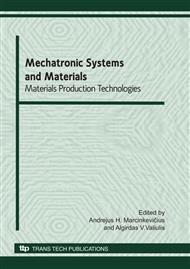p.207
p.210
p.216
p.221
p.226
p.231
p.237
p.244
p.250
Determination of Temperature Range Enabling the Plastic Deformation Process of CP302 Solder
Abstract:
The development of new technologies of metal joining processes including brazing methods requires improvement of solder properties. Copper-based brazing solders with phosphorus and tin additions belong to the group of silver-free brazing alloys with low ductility. The most common form of these solders are bars and wires so there is a need to determine the causes of technological problems concerned with plastic deformation of the solders. In the literature, except for the chemical composition and temperature of brazing, we can not find the details regarding the change of solder structure during heating processes. The preliminary tests carried out in the industry indicate high plasticity of solder in the narrow range of temperature. This encouraged the authors of the paper to perform dilatometric testing with the aim of establishing the precise temperatures of solder phase changes. The metallographic research with the use of scanning electron microscopy enabled the determination of phase composition of “freezing” structures and the evaluation of their flexibility to the plastic deformation.
Info:
Periodical:
Pages:
226-230
Citation:
Online since:
June 2010
Authors:
Keywords:
Price:
Сopyright:
© 2010 Trans Tech Publications Ltd. All Rights Reserved
Share:
Citation:


